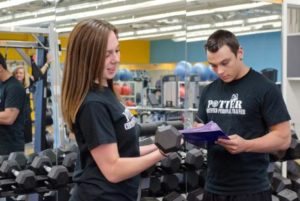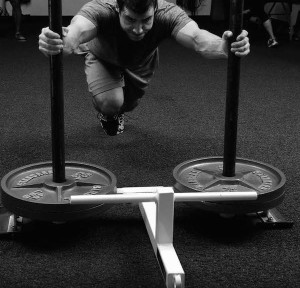Introduction
To date physiologists have extensively explored fatigue and recovery in metabolic terms resulting in a significant body of literature focusing on by-products of exercise such as lactate and phosphate. A review of the literature revealed a significantly lesser number of papers examining the neural aspects of fatigue, particularly central fatigue. Possible reasons for this might be the increased difficulty in measuring and assessing neural components such as nerve conduction velocity (Ross et al. 2001) and neural drive (Noakes, 2000).
Nevertheless it is evident that the central aspect of neural fatigue requires further investigation, and several studies looking at reflex responses (Koceja et al. 2004 and Ross et al. 2001) provide interesting initial findings. There is no question that the next logical step for researchers is to look at the neural changes/adaptations within different sporting contexts in order to expand on the knowledge base that currently exists.
Definitions
When reviewing the literature pertaining to neural fatigue in speed/power sports, it is important to construct a working definition of “neural fatigue” and differentiate between central and peripheral mechanisms.
Garrandes et al. (2005) offer a rather simplistic but effective explanation: “central fatigue, involves insufficient neural drive to the muscles, and peripheral fatigue includes changes beyond the neuromuscular junction” (p 113). A more detailed description of the possible sites of fatigue (both central and peripheral) is provided by Paasuke et al. (1999) as “excitatory input to motor cortex, excitatory drive to lower motor neurone, motor neurone excitability, neuromuscular transmission, sarcolemma excitability, excitation-contraction coupling, contractile mechanism, metabolic energy supply” (p 319). The same authors also admit that the relative contributions of central and peripheral fatigue are not well understood.
Several authors also mention the tern neural plasticity which is defined by Armstrong and VanHeest (2002) as “the process whereby patterns of impulses into mature synapses can cause long-lasting changes in the magnitude of the subsequent stimulation” (p 199).
This paper will examine both peripheral and central fatigue mechanisms as they apply to speed/power sports.
Central fatigue
Noakes (2000) proposes two (2) models to explain central fatigue in power sports. The first model states that brain concentrations of neurotransmitters (serotonin, dopamine, acetylcholine) alter the density of neural impulses (or rate coding) to the muscle during exercise. However the same author also states that “no specific physiological value or importance is assigned to this phenomenon” (p 138) and it is also noted that no other article reviewed made mention of neurotransmitter concentrations as a possible mechanism for central fatigue. Therefore the measurement of neurotransmitter concentrations to determine central fatigue is not supported in the literature.
Alternatively Noakes (2000) proposes that during states of fatigue central activation decreases in order to protect the individual from the following scenarios during exercise:
- Myocardial ischemia
- Muscle rigor due to ATP depletion
- Falls in blood pressure
- Heatstroke
- Glucopaenic brain damage.
This protective mechanism is also mentioned by Gabriel et al. (2001) as a decrease in motor unit firing that occurs in order to prevent peripheral fatigue from manifesting itself at a local level through depleted Na+ or ATP. This theory then suggests that assessment of peripheral markers will not provide a valid assessment of the neural state of an athlete. However it should be mentioned that this article examined isometric elbow extension strength. Whether these findings can be extrapolated to more dynamic sporting situations such as those that are common in speed/power sports remains to be seen.
Electromyography (EMG) has been commonly used to assess both central and neural fatigue. Hautier et al. (2000) used an EMG/force ratio to determine the degree of central fatigue in sprint cycling. Specifically, a constant EMG/force ratio concurrent with a force decrease was indicative of central fatigue. Although the investigators did not encounter this phenomenon their study, they do admit that centrally mediated patterns may have contributed to altered intermuscular coordination under fatigue. Paasuke et al. (1999) also commented that athletes participating in sports requiring rapid, intense contractions require a different functional organisation of the neuromuscular system. Whether the EMG/force ratio proposed by Hautier et al. (2000) can be used as a measure of central recovery/fatigue remains a question for further research.
A significant amount of research examined reflexes as a measure of central fatigue. Ross et al. (2001) suggest that several neurological parameters can be altered in response to exercise. These parameters are nerve conduction velocity (NCV), maximum EMG, motor-unit recruitment strategy and Hoffman reflex (H-reflex).
Although no real trend has emerged with NCV and performance (Ross et al. 2001), the authors do suggest that a threshold exists beyond which exercise may have a negative affect on axon diameter and myelination thereby affecting NCV. This in turn would affect impulse frequency and muscle activation. However controversy does appear to exist with regard to the methods used to measure NCV as opposed to muscle contraction velocity which is easily measured by EMG. It could be that accurate assessment of NCV may provide useful information as to the extent of central fatigue in athletes; however more research is needed to validate this method.
Koceja et al. (2004) looked at the stretch reflex as an indicator of central fatigue and the relevance of this for speed/power athletes is explained by Ross et al. (2001) – “stretch reflexes appear to be enhanced in sprint athletes possibly because of increased muscle spindle sensitivity as a result of sprint training” (p 409-410). Koceja et al. (2004) propose that the patella tendon-tap reflex results in a more forceful contraction in sprint-trained athletes compared to those trained for endurance. The same authors cite a study by Hakkinen and Komi (1983) who found that short-term exercise decreased the EMG/force ratio which was also proposed as a marker of central fatigue by Hautier et al. (2000).
The H-reflex differs from the stretch reflex in that the afferent nerves are directly stimulated rather than via the patella tendon (Koceja et al. 2004). The authors postulate that this removes the confounding affect of the muscle spindle and allows a more accurate indication of motoneuron excitability. Koceja et al. (2004) propose using a Hmax:Mmax ratio that represents the connectivity between Ia afferent fibres and the motoneurons to a particular muscle. The authors also propose that a change in this ratio after training “represents a reorganisation of the motor pool” (p 26) that is lower in trained athletes.
Ross et al. (2001) also support this theory and comment that reflex sensitivity is diminished when a large volume of exercise that utilises the stretch shortening cycle (SSC) is undertaken. However the same authors also state that metabolic by-products such as lactate can also inhibit SSC activity. An interesting experiment could examine if a correlation exists between the Hmax:Mmax ratio and lactate accumulation.
Ross et al. (2001) also suggest that proprioceptive deficit and perceived exertion difficulties are the result of muscle damage affecting neural function. It is interesting to note that this is in direct contrast to Noakes et al. (2000) who commented that central nervous system deactivation occurs to protect the periphery from damage.
Drust et al. (2005) found that the ability to produce power during repeated cycle sprints is impaired when core and muscle temperatures are both elevated. The authors found that hyperthermia may have altered CNS function through mechanisms such as:
- Altered brain activity
- Reduced cerebral blood flow
- Increased whole-brain energy turnover
- Reduced muscle activation.
This has implications for the warm-up protocols employed prior to speed/power events as metabolic factors did not appear to have an effect on the reduced performance. The measurement of core and muscle temperature may provide valuable information in sports/events that require repeated high-intensity efforts. However it should be noted that Drust et al. (2005) only used grip strength to assess the ability to activate muscle rather than the tests mentioned previously in this review.
Two (2) of the studies reviewed examined power output as a measure of central fatigue (Hoffman et al. 2003 and Ronglan et al. 2006). Hoffman et al. looked at female soccer players and found that power (assessed through squat jump and counter-movement jump) had not decreased at the end of the game, but was impaired 24 hours later. The authors make no comment on possible neural fatigue mechanisms, however it may be plausible that simple tests such as squat jump and countermovement jump (CMJ) could be used to assess the state of the nervous system.
Ronglan et al. (2006) examined elite female handball players through a number of power/speed tests (including CMJ). The authors concluded that decreases in leg power could be due to both central and peripheral factors but suggest that changes within the muscle were more likely to have caused the reduced performance. Interestingly Ronglan et al. (2006) propose that neuromuscular fatigue seems to recover within a few minutes which is not supported by other literature.
Peripheral fatigue
As was mentioned in the definitions section of this paper, peripheral fatigue is defined as the changes that occur beyond the neuromuscular junction and are known as “local” factors (Garrandes et al. 2005). For the purposes of this paper, discussion will be limited to neural rather than metabolic aspects of fatigue and subsequent recovery
Paasuke et al. (1999) examined neuromuscular fatigue of the knee extensors and measured electromechanical delay (the time delay between the beginning of EMG response and onset of limb movement) and other aspects of the patella reflex. They commented that “one of the variables which enables us to assess central and peripheral processes in human motor system is reaction time to visual or auditory stimulus” (p 324). The results found that the fatigue was due to failure of the muscle contractile process rather than neural factors. This is supported by Garrandes et al. (2005) who found that power-trained men demonstrated impaired excitation-contraction coupling within the knee extensors. However it must be noted that the power of this study is poor with only seven (7) power athletes participating as opposed to fourteen (14) endurance athletes.
Several studies used sprint cycling and EMG to determine the origin/s of fatigue. Hunter et al. (2003) examined EMG during the wingate cycle test and compared the results to maximal voluntary contractions (MVC) of the knee extensors. The results showed no change in motor unit recruitment strategy during the cycle test despite a significant decrease in power as the test progressed (30 seconds).
The authors postulate that the fatigue was due to intramuscular metabolite accumulation rather than neural factors. However they also propose that the CNS may down-regulate muscle contraction as a protective mechanism beyond 30 seconds. This then suggests that there may be some merit in using EMG amplitude during a power test beyond 30 seconds in duration to assess CNS activity and neural recovery.
Glaister et al. (2005) also examined fatigue during intermittent sprint cycling rather than the continuous wingate protocol. Although this study did not measure EMG the authors found that power output could be maintained even though blood lactate levels were elevated suggesting that metabolic acidosis is not a limiting factor in excitation-contraction coupling in intermittent speed/power exercise.
Jereb and Strojnik (2003) propose that two (2) types of peripheral fatigue exist. The high frequency model is prevalent in intense exercise that utlises the SSC where the cause of fatigue is impaired action potential propagation along the muscle fiber. Low frequency fatigue is more common in submaximal exercise. A 15 second wingate test was conducted which was followed by electrical stimulation of the vastus lateralis. The results showed that both low and high frequency fatigue occurred as evidenced by reduced torque at high (100 Hz) and low (20 Hz) levels of electrical muscle stimulation. The authors proposed that high frequency fatigue was due to an imbalance in Na+ and K+ concentrations that reduced impulse propagation along the cell membrane, whereas low frequency fatigue was due to impaired Ca2+ release from the sarcoplasmic reticulum. This then suggests that measurement of fatigue (and therefore recovery) should consider both neural and metabolic aspects.
Augustsson et al. (2006) used a single-leg hop test to assess fatigue and also commented on the high and low frequency fatigue theory proposed by Jereb and Strojnik (2003). The authors proposed that the induced fatigue was peripheral in nature. When performing the single-leg hop test under fatigue, subjects altered hip and knee flexion angles and produced less ground-reaction forces during take-off and landing. Although the technical aspects of this test require subjective analysis, there appears to be some credence in assessing ground-reaction forces and hop distance to determine the extent of recovery.
Downhill skiing implications
No literature was found that addressed neural fatigue and recovery for downhill skiing. However a paper written by Stoggl et al. (2006) performed an in-depth analysis of cross-country skiing competition. The authors state that a typical downhill “run” is completed in approximately 2 minutes and 50 seconds which is comparable to running 800-1500 metres. A typical competition will see an athlete compete in four (4) heats with a total competition time around 3-4 hours. Therefore the importance of monitoring and enhancing recovery for these athletes becomes evident.
Stoggl et al. (2006) point out that “good skiing technique and skiing economy are probably the most important characteristics for a good sprinter” (p 1). More specifically, the authors found that elite performers had greater strength and power characteristics, particularly in the upper body. To this end Stoggl et al. (2006) list neuromuscular factors such as voluntary and reflex neural activation and force of myofibrillar cross-bridge activity as important characteristics for downhill skiing. Therefore it may be applicable to monitor these athletes using some of the previously mentioned techniques such as EMG:force ratio, reflex analysis and power decrement. Only further published research in this area will enable such methods to be validated scientifically rather than anecdotally.
Conclusion
Assessment of fatigue has historically concentrated on biochemical markers to provide in indication of recovery status. However in recent times more work has been done in the area of neural fatigue with investigators looking more closely at indicators such as reaction times and reflex arcs. Some investigators have also examined power and force decrement as indicators of fatigue and recovery within speed/power sports. Although research on the area of neural fatigue is in its infancy, initial findings do appear encouraging even though considerable debate exists about whether neuromuscular fatigue is due to central and/or peripheral factors.
The research reviewed in this paper has pointed to the possible use of several markers for neural fatigue including, elevated core and muscle temperature, reflex inhibition (patella tendon and Hoffman), EMG:force ratio and Hmax:Mmax ratio. However the search for measurements that are easy to administer and inexpensive are now being investigated with power decrement tests being explored as a possible marker that can be modified to better suit different sports/events.
References
Armstrong, L.E. and VanHeest, J.L. The unknown mechanism of the overtraining syndrome. Clues from depression and psychoneuroimmunology. Sports Med. 32(3):185-209, 2002.
Augustsson, J., Thomee, R., Linden, C., Folkesson, M., Tranberg, R. and Karlsson, J. Single-leg hop testing following fatiguing exercise: reliability and biomechanical analysis. Scandinavian Journal of Medicine and Science in Sports. 16:111-120, 2006.
Drust, B., Rasmussen, P., Mohr, M., Nielson, B. and Nybo, L. Elevations in core and muscle temperature impairs repeated sprint performance. Acta Physiol Scand. 183:181-190, 2005.
Gabriel, D.A., Basford, J.R. and An, Kai-An. Neural adaptations to fatigue: implications for muscle strength and training. Medicine and Science in Sports and Exercise. 33(8):1354-1360, 2001.
Garrandes, F., Colson, S.S., Pensini, M. and Legros, P. Neuromuscular fatigue kinetics are sport specific. Computer Methods in Biomechanics and Biomedical Engineering. Supplement 1:113-114, 2005.
Glaister, M., Stone, M., Stewart, A.M., Hughes, M. and Moir, G.L. The influence of recovery duration on multiples sprint cycling performance. Journal of Strength and Conditioning Research. 19(4):831-837, 2005.
Hautier, C.A., Arsac, L.M., Deghdegh, K., Souquet, J., Belli, A. and Lacour, J. Influence of fatigue on EMG/force ratio and cocontraction in cycling. Medicine and Science in Sports and Exercise. 32(4):839-843, 2000.
Hoffman, J.R., Nusse, V. and Kang, J. The effect of an intercollegiate soccer game on maximal power performance. Canadian Journal of Applied Physiology. 28(6):807-817, 2003.
Hunter, A.M., St Clair Gibson, A, S., Lambert, M.I., Nobbs, L. and Noakes, T.D. Effects of supramaximal exercise on the electromyographic signal. British Journal of Sports Medicine. 37(4):296-299, 2003.
Jereb, B. and Strojnik, V. Neuromuscular fatigue after short maximal cycling exercise. Kinesiology. 35(2):135-142, 2003.
Koceja, D.M., Davison, E. and Robertson, C.T. Neuromuscular characteristics of endurance-and power-trained athletes. Research Quarterly for Exercise and Sport.75(1):23-30, 2004.
Neilson, J.J., Mohr, M., Klarskov, C., Kristensen, M., Krustrup, P., Juel, C. and Bangsbo, J. Effects of high-intensity intermittent training on potassium kinetics and performance in human skeletal muscle. Journal of Physiology. 554(3):857-870, 2003.
Noakes, T.D. Physiological models to understand exercise fatigue and the adaptations that predict or enhance athletic performance. Scandinavian Journal of Medicine and Science in Sports. 10:123-145, 2000.
Paasuke, M., Ereline, J. and Gapeyeva, H. Neuromuscular fatigue during repeated exhaustive submaximal static contractions of knee extensor muscles in endurance-trained, power-trained and untrained men. Acta Physiol Scand. 166:319-326, 1999.
Ronglan, L.T., Raastad, T., Borgesen, A. Neuromuscular fatigue and recovery in elite female handball players. Scandinavian Journal of Medicine and Science in Sports. 16:267-273, 2006.
Ross, A., Leveritt, M. and Riek, S. Neural influences on sprint running. Training adaptations and acute responses. Sports Med. 31(6):409-425, 2001.
Stoggl, T., Lindinger, S. and Muller, E. Analysis of a simulated sprint competition in classical cross country skiing. Scandinavian Journal of Medicine and Science in Sports. Accepted for publication 4 July, 2006.




